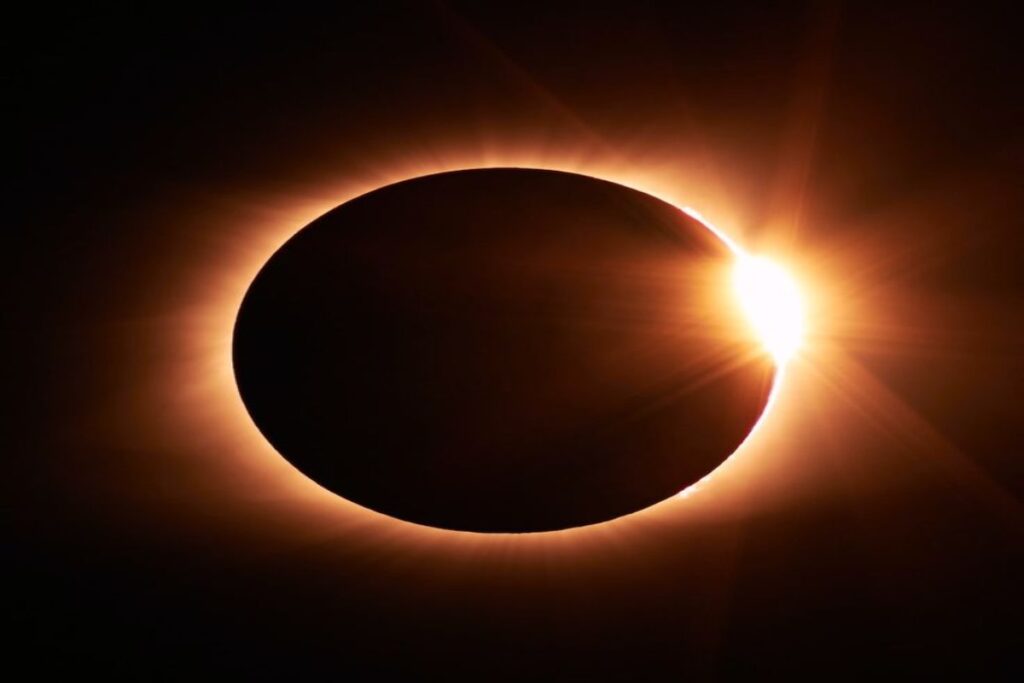On April 8, 2024, a total solar eclipse will cross North America, passing over Mexico, the United States, and Canada. A total solar obscuring happens when the Moon passes between the sun and the Earth, completely blocking the face of the sun. Then, the sky will darken as if it were dawn or dusk.
People viewing the darkening from locations where the Moon’s shadow completely covers the sun – known as the path of totality – will experience a total solar eclipse. If the sky is clear, people along the path of totality will see the sun’s corona or outer atmosphere. This part is usually obscured by the bright face of the sun.
A total solar darkening is the only type where viewers can momentarily remove their eclipse glasses. These glasses are not the same as regular sunglasses; they are usually darker and must comply with ISO 12312-2 international safety standards, according to NASA.
However, you can only remove your eclipse glasses safely during what we know as totality. This is the brief period when the Moon is completely blocking the sun. NASA also says you should not look at the eclipse through a camera lens, binoculars, or telescope, even while wearing eclipse glasses. The solar rays can burn through the lens and cause serious eye injury.
Safety should be the number one priority when viewing a total eclipse. Be sure you’re familiar with when you need to wear the specialized eye protection designed for solar viewing. Also, there are ways you can indirectly view the eclipse, like through a homemade pinhole projector.
The solar eclipse will start on Mexico’s Pacific coast around 11:07 a.m. PDT. It will then travel across parts of the US and into Canada. The darkening will leave continental North America at 5:19 p.m. EDT. According to NASA, the next solar eclipse visible from the US will occur on August 23, 2044.
The last one that was visible from the US happened in August 2017. It was the first total eclipse to pass over the entire continent in nearly 100 years. Furthermore, an annual solar eclipse was visible for parts of the US on October 14, 2023. However, NASA reported that the sun wasn’t covered.
According to NASA, about 31.6 million people live in the 200-mile path of totality, which means they will be able to see the obscuring. For the 2017 eclipse, an estimated 12 million people saw the total solar eclipse.
ALSO READ: Court Sentences Former CIA Agent to Forty Years in Prison for Largest Data Breach in Agency History
According to NASA, southern Texas will see the total eclipse around 1:40 p.m. local time after it passes over Mexico in the early afternoon. Afterward, parts of Oklahoma will notice the darkening beginning at 1:45 p.m.
Then Arkansas at around 1:51 p.m. And southeast Missouri around 1:56 p.m. The eclipse will hit Illinois, Kentucky, and Indiana around 2 p.m. and Ohio around 3:13 p.m. Also, parts of Pennsylvania will start seeing the total darkening around 3:16 p.m.
NASA also claims parts of northwestern New York will also see it shortly after 3:18 p.m. Afterward, it will move over parts of Vermont, New Hampshire, and Maine before hitting Canada around 4:25 p.m.
You Might Also Like:
Texas Woman and Infant Son Dies in Tragic House Fire
Shane Gillis Returns To Stage As Host Years After SNL Controversy
Florida Park Sets Record, Hosts Nearly a Thousand Manatees
The Most Daring Looks From the 2024 Grammys Red Carpet
Fans Slam Alyssa Milano, Gwyneth Paltrow, Kim Kardashian, Others, for Being “Out of Touch
